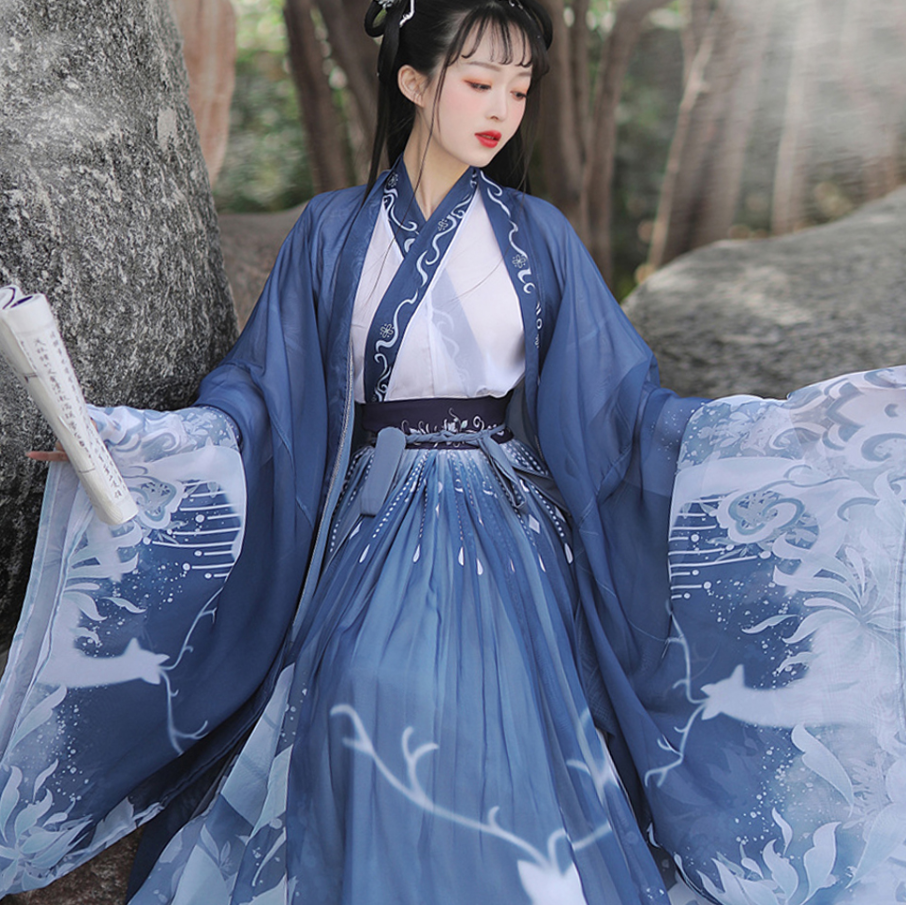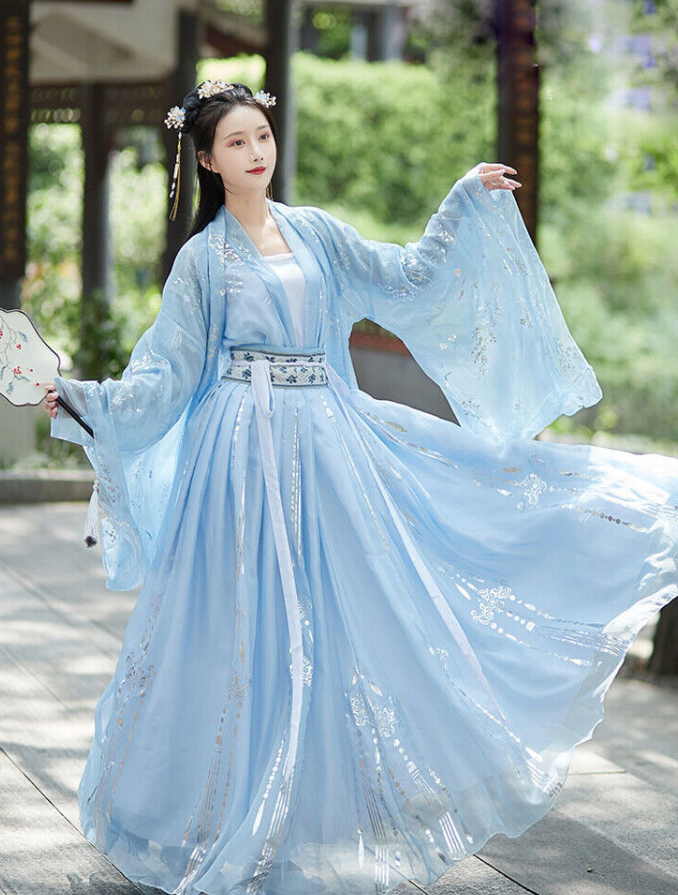Blue hanfu symbolizes tranquility, depth, introspection, and connection to nature in Chinese culture.
The Symbolism of the Color Blue in Chinese Culture
In traditional Chinese culture, colors have always played a significant role in symbolism and representation. The color blue, known as “青” (qīng) in Chinese, embodies a range of meanings and emotions.

Cultural Associations
Blue, in many cultures including Chinese, is often associated with tranquility, stability, and peace. Yet, its interpretation in China goes beyond just these generic associations:
- Sky and Heaven: Blue, especially in its lighter shades, represents the vastness of the sky and is often linked to the heavens. In ancient Chinese mythology, the heavens were thought to be the abode of deities and celestial beings, giving blue a divine and spiritual connotation.
- Water and Ocean: Blue also draws parallels with water, signifying flow, flexibility, and life. Given China’s long coastline and significant rivers like the Yangtze, the color has always had a deep connection with water bodies.
- Immortality and Eternity: Blue objects, such as ceramics, often adorned tombs and burial sites, signifying a wish for immortality and eternal life. The famous blue and white porcelain of the Ming Dynasty is a testament to this association.
Historical Context
Historically, the significance and use of blue evolved with changing dynasties and cultural shifts:
- Ancient Dynasties: In early dynasties, blue was primarily derived from natural sources like plants. The process was intricate, making blue a less commonly used color compared to, say, red or yellow.
- Ming Dynasty (1368–1644): The era saw a surge in the use of blue, especially in art and ceramics. It was during this period that blue and white porcelain became globally recognized. The blue motifs on these porcelains often depicted stories, nature, or historical events.
- Modern Interpretations: With globalization and cultural exchange, the meaning of blue in China began to incorporate more global perceptions. Today, while it still retains its traditional meanings, it is also seen as a color representing modernity, progress, and global connections, especially in urban settings like Shanghai or Beijing.
Variations of Blue in Hanfu
The allure of the hanfu lies not just in its design but also in the intricacies of its colors. Within the spectrum of blue, the variations tell stories, convey emotions, and hold significance that goes beyond aesthetics.
Deep Blue vs. Light Blue
While both shades fall under the blue spectrum, they carry different connotations and have been used in diverse contexts in the realm of hanfu:
- Deep Blue: This shade is often likened to the night sky, representing mystery, depth, and introspection. In historical contexts, deep blue was a choice for ceremonies and rituals, as it conveyed a sense of solemnity and respect. It’s a color that evokes feelings of wisdom, authority, and integrity.
- Light Blue: Resonating with the clear daytime sky or calm waters, light blue symbolizes peace, tranquility, and purity. In the world of hanfu, light blue garments were popular during spring and summer months, reflecting the vibrancy and renewal of these seasons. It’s also a color that was commonly associated with youth and vitality.
Common Materials and Dyes Used
The beauty of blue in traditional Chinese garments is often a result of the dyes and materials used:
- Natural Dyes: Historically, indigo plants were a primary source for extracting blue dyes. The indigo dyeing process involved fermenting the plants to produce a range of blue shades. The richness and depth of the color depended on the number of dyeing cycles the fabric underwent.
- Silk: Recognized as a luxurious material, silk was often dyed in various blue hues to produce hanfu garments for the elite. The sheen and texture of silk enhanced the vibrancy of the blue, making it a preferred choice for special occasions.
- Cotton and Linen: For everyday wear, especially during warmer months, hanfu made from cotton or linen dyed in blue shades was more prevalent. These materials, being breathable, provided comfort while also allowing wearers to display elegance and style.
Comparing Blue Hanfu with Other Colors
Chinese culture boasts a vibrant palette of colors, each holding its symbolism and significance. When we look at the world of hanfu, it’s fascinating to see how each color tells its own tale and how they compare to one another.
The Meaning of Red, Yellow, and Green Hanfu
Each of these colors in the context of hanfu carries a weight of historical and cultural meanings:
- Red Hanfu: Perhaps the most iconic color in Chinese culture, red is synonymous with happiness, prosperity, and good luck. It’s the preferred choice for celebrations like Lunar New Year or weddings. In history, red garments were worn by brides to symbolize happiness and auspicious beginnings. The Lunar New Year celebrations are often a sea of red, representing hopes for a prosperous year ahead.
- Yellow Hanfu: Historically, yellow was a color reserved for the emperors. It symbolized power, authority, and the center of the universe. The Imperial robes during various dynasties were predominantly yellow, signifying the emperor’s divine connection and mandate from heaven. The Forbidden City in Beijing, the imperial palace, showcases this color extensively.
- Green Hanfu: Green typically represents growth, harmony, and freshness. In the context of hanfu, green garments were popular during spring, symbolizing renewal and the rebirth of nature. It’s a color that connects the wearer to the natural world, reflecting the Chinese appreciation for landscapes and nature.
How Blue Stands Out
While each color holds its importance, blue, with its depth and versatility, has its unique place:
- Tranquility and Depth: Unlike the fiery passion of red or the imperial grandeur of yellow, blue embodies calmness, depth, and introspection. It’s a color that invokes feelings of serenity, making it a popular choice for scholars and thinkers in history.
- Flexibility: Blue’s spectrum, from deep navy to soft sky blue, provides a versatility that few other colors offer.
- Connection with Nature: Just as green connects with plants and forests, blue resonates with the vastness of the sky and the depths of oceans and rivers. Wearing blue hanfu becomes a nod to nature’s magnificence and the Yin-Yang philosophy of balance and harmony.
Designs and Embroideries on Blue Hanfu
The world of hanfu isn’t just about colors; it’s an intricate tapestry where design meets symbolism. The blue hanfu, with its calm and serene backdrop, provides an ideal canvas for intricate designs and embroideries to shine through.
Common Patterns and Their Meanings
The embroideries and patterns on blue hanfu are not mere decorations; they narrate tales, beliefs, and aspirations:
- Dragons and Phoenixes: A popular motif in Chinese culture, the dragon symbolizes power, strength, and good luck, while the phoenix represents renewal and the eternal cycle of life. When embroidered on blue hanfu, they evoke a sense of harmony between the heavens (represented by blue) and these mythical creatures.
- Floral Patterns: Flowers like peonies, lotuses, and orchids are frequently embroidered on hanfu. The peony, for instance, symbolizes prosperity and honor. The lotus, emerging from mud yet unstained, signifies purity and divine beauty.
- Clouds and Waves: Reflecting the connection with nature, patterns of clouds and waves signify life’s transient nature and the flow of time. On a blue backdrop, these patterns enhance the garment’s celestial and aquatic connections.
- Bamboo and Pine: Representing resilience and endurance, these plants, when embroidered on blue hanfu, provide a contrast of strength against the calmness of the blue.

Integration with Other Colors
While blue stands magnificent on its own, its integration with other colors through designs amplifies its beauty:
- Blue and White: One of the most classic combinations, white patterns on blue hanfu give it a pristine and elegant look. The contrast brings out the intricacies of the design, whether it’s delicate floral motifs or bold geometrical patterns.
- Blue and Gold: Reminiscent of the night sky dotted with stars, gold embroideries on blue hanfu add a touch of regality and grandeur.
- Blue and Green: Reflecting the myriad hues of nature, from the sky to the forests, this combination is harmonious and pleasing to the eye.